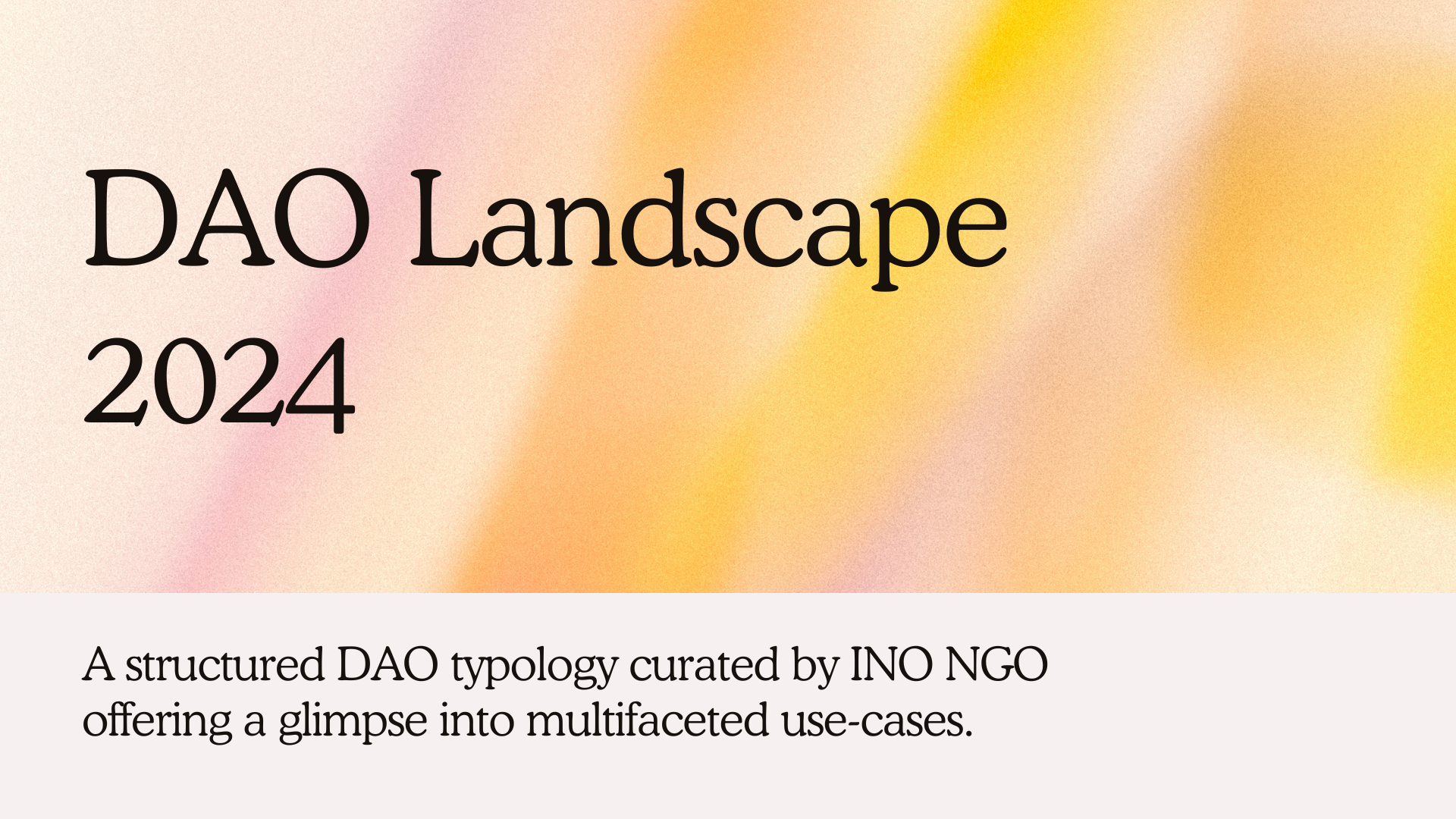DAO Landscape 2024
A structured DAO typology curated by INO NGO offering a glimpse into multifaceted use-cases.

Interested in seeing the DAO Landscape Graphic? Jump directly to it here.
Decentralized Autonomous Organizations (DAOs) mark a pivotal shift in governance and collective decision-making, leveraging blockchain technology to democratize operations and ownership.
Born from the ethos of decentralization, DAOs empower communities to steer projects and funds without centralized authority. This evolution signifies technological innovation and a cultural shift towards transparency, equity, and participatory governance, challenging traditional organizational structures.
Reflecting on data from DeepDAO as of February 6, 2024, with nearly 19,839 established DAOs, over 10 million governance token holders, and a staggering collective treasury surpassing $30.3 billion, it's evident that DAOs are forging a transformative path, reshaping how we conceive collaboration and ownership in the digital age.
The Importance of Typology in Understanding DAOs
A structured DAO typology curated by INO NGO offers a fresh perspective on the multifaceted ecosystem - updating earlier landscape versions designed years ago. Understanding DAOs through the lens of typology—categorizing them as generative, collaborative, or inventive—clarifies their objectives and potential.
This classification aids stakeholders in grasping the diverse functions and ambitions of DAOs, from fostering innovation and managing communities to achieving targeted goals. Such a framework demystifies the operational mechanisms of DAOs and highlights their unique contributions to the digital ecosystem, enabling informed participation and investment decisions.
Exploring Generative DAOs
Generative DAOs are visionaries in the digital realm, actively bringing new ideas and assets to life. They operate across three main areas: building structural frameworks and protocols that form the backbone of the digital ecosystem, making strategic investments to fuel innovation and growth, and producing cultural works that enrich and engage their communities.
Through these activities, generative DAOs contribute to blockchain's technological advancement and foster a vibrant culture of creativity and production.
Generative DAOs are divided into three areas: Structural, Investment and Production. Below are Generative DAO examples:
Structural
Investment
Production
Highlighting Collaborative DAOs
Collaborative DAOs are central to harmonizing individual efforts towards collective goals, emphasizing governance, philanthropy, and cooperation.
They refine community functions, propel public goods funding, and streamline on-chain management, leveraging value transfer mechanisms for impactful resource allocation.
Through managing resources and protocols, initiating charitable endeavors, and fostering joint efforts, these DAOs cultivate a strong foundation for communal growth and shared success in the blockchain environment.
Collaborative DAOs are divided into three areas: Governance, Philanthropic and Cooperation. Below are Collaborative DAO examples:
Governance
Philanthropic
- KilmaDAO
- GitCoin
- MolochDAO
- EduDAO
- Le Xpunk
- Clr.fund
- UkraineDAO
- OptimismCollective
- Radical xChange
- Big Green DAO
Cooperation
Understanding Inventive DAOs
Inventive DAOs are catalysts for innovation, focused on uncovering new insights and possibilities. They engage in research to advance science and understanding, build technical systems and infrastructure, and leverage collective intelligence for emergent cognition.
These DAOs are defined by their goal-oriented missions, often disbanding after achieving their objectives. By organizing people for collective action, they explore uncharted territories, demonstrating the power of collaborative effort in driving the blockchain ecosystem forward.
Inventive DAOs are divided into three areas: Research, Data & Infrastructure, and Collective Intelligence. Below are Inventive DAO examples:
Research
Data & Infrastructure
Collective Intelligence
The DAO Landscape Graphic
The DAO Landscape graphic ingeniously maps the multifaceted world of DAOs, distinguishing them into generative, collaborative, and inventive categories.
This visual tool aids readers in understanding the diverse objectives and operational strategies DAOs employ, from advancing technology and fostering community to pioneering research and infrastructure development.
By articulating these distinctions through a clear, engaging design, the graphic serves as a navigational compass, guiding stakeholders through the complexities of the DAO ecosystem and highlighting the unique contributions of each type to the internet-native landscape.

Future Trends and Evolution of DAOs
The future of DAOs sees a transformative shift towards Internet Native Organizations (INO), which embody decentralization while being globally accessible and legally compliant. INOs mark a new era of collaboration.
INO represents an evolution with a governance model that is both code-driven and community-oriented, emphasizing transparency, inclusivity, and decentralized decision-making. This evolution towards INO from DAO is driven by the need for broader acceptance, legal compliance, and a global, digital-first approach. This ensures that these entities operate within a clear regulatory framework and are designed for mainstream adoption.
Conclusion
Understanding DAO typologies is crucial for anyone involved in the DAO arena, offering clarity on their varied goals and operational methods. This comprehension is key for informed engagement and investment. Readers are encouraged to dive into the DAO ecosystem, leveraging this newfound understanding to participate more effectively and contribute to the diverse landscape of internet-native organizations.
